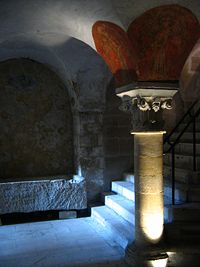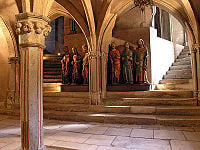Difference between revisions of "Crypt" - New World Encyclopedia
(Claimed) |
(Copied from wikipedia) |
||
| Line 1: | Line 1: | ||
{{Claimed}} | {{Claimed}} | ||
| + | [[Category:Politics and social sciences]] | ||
| + | [[Category:Anthropology]] | ||
| + | |||
| + | |||
| + | {{this|the stone chambers called "crypts"|Crypt (disambiguation)}} | ||
| + | [[Image:Bayeux-crypte1.JPG|200px|thumb|Crypt of Bayeux, France]] | ||
| + | [[Image:Crypte de St Sernin Toulouse.jpg|thumb|right|200 px|Crypt [[Saint-Sernin Basilica]] [[Toulouse]]]] | ||
| + | |||
| + | In [[medieval]] terms, a '''crypt''' (from the [[Latin]] ''crypta'' and the [[Greek language|Greek]] ''kryptē'') is a stone chamber or vault, usually beneath the floor of a church or [[castle]], usually used as a [[chapel]] or [[burial vault (tomb)|burial vault]] possibly containing [[sarcophagus|sarcophagi]], [[coffin]]s or [[relic]]s of important persons such as [[saint]]s or high ranking church officials. | ||
| + | |||
| + | ==Description== | ||
| + | Churches were occasionally raised above ground level to accommodate a crypt at the ground level, such as [[St. Michael's Church, Hildesheim|St. Michael's Church]] in [[Hildesheim]], Germany. Crypts are typically found below the [[apse]] such as at [[Saint-Germain en Auxerre]], but occasionally found beneath church wings and [[nave]]s. First known in the early Christian period, in particular North Africa at [[Ech-Cheliff|Orleansville]] and [[Djemila]] in [[Algeria]], and [[Byzantium]] at [[Saint John Studio]] in [[Constantinople]], crypts were first used and spread widely in western Europe under [[Charlemagne]], they are most common in the early medieval West, for example in [[Burgundy]] at [[Dijon]] and [[Tournus]]. After the 10th century the need for crypts faded, when Church officials permitted relics to be held in the main level of the church. By the [[Gothic architecture|Gothic]] period crypts were rarely built. | ||
| + | |||
| + | ==Burial vaults== | ||
| + | :''Main article: [[Burial vault (tomb)]]''. | ||
| + | In more modern terms, a crypt is most often a stone chambered [[burial vault (tomb)|burial vault]] used to store the deceased. Crypts are usually found in [[cemetery|cemeteries]] and under public religious buildings, such as [[church]]es or [[cathedral]]s, but are also occasionally found beneath [[mausoleum|mausolea]] or [[chapel]]s on personal estates. Wealthy or prestigious families will often have a 'family crypt' or 'vault' in which all members of the family are stored. Many [[royal family|royal families]], for example, have vast crypts containing the bodies of dozens of former royals. In some localities an above ground crypt is more commonly called a [[mausoleum]], which also refers to any elaborate building intended as a burial place, for one or any number of people. | ||
| + | |||
| + | ==Examples== | ||
| + | *[[Lund Cathedral]], Sweden | ||
| + | *[[Muchalls Castle]], Scotland | ||
| + | |||
| + | ==See also== | ||
| + | *[[Catacomb]] | ||
| + | *[[Grave (burial)|Grave]] | ||
| + | *[[Mausoleum]] | ||
| + | *[[Ossuary]] | ||
| + | *[[Reliquary]] | ||
| + | *[[Tomb]] | ||
| + | |||
| + | |||
| + | |||
| + | {{Credits|Crypt|124163259|}} | ||
Revision as of 02:54, 7 June 2007
- This article is about the stone chambers called "crypts". For other uses of the term, see Crypt (disambiguation).
In medieval terms, a crypt (from the Latin crypta and the Greek kryptē) is a stone chamber or vault, usually beneath the floor of a church or castle, usually used as a chapel or burial vault possibly containing sarcophagi, coffins or relics of important persons such as saints or high ranking church officials.
Description
Churches were occasionally raised above ground level to accommodate a crypt at the ground level, such as St. Michael's Church in Hildesheim, Germany. Crypts are typically found below the apse such as at Saint-Germain en Auxerre, but occasionally found beneath church wings and naves. First known in the early Christian period, in particular North Africa at Orleansville and Djemila in Algeria, and Byzantium at Saint John Studio in Constantinople, crypts were first used and spread widely in western Europe under Charlemagne, they are most common in the early medieval West, for example in Burgundy at Dijon and Tournus. After the 10th century the need for crypts faded, when Church officials permitted relics to be held in the main level of the church. By the Gothic period crypts were rarely built.
Burial vaults
- Main article: Burial vault (tomb).
In more modern terms, a crypt is most often a stone chambered burial vault used to store the deceased. Crypts are usually found in cemeteries and under public religious buildings, such as churches or cathedrals, but are also occasionally found beneath mausolea or chapels on personal estates. Wealthy or prestigious families will often have a 'family crypt' or 'vault' in which all members of the family are stored. Many royal families, for example, have vast crypts containing the bodies of dozens of former royals. In some localities an above ground crypt is more commonly called a mausoleum, which also refers to any elaborate building intended as a burial place, for one or any number of people.
Examples
- Lund Cathedral, Sweden
- Muchalls Castle, Scotland
See also
Credits
New World Encyclopedia writers and editors rewrote and completed the Wikipedia article in accordance with New World Encyclopedia standards. This article abides by terms of the Creative Commons CC-by-sa 3.0 License (CC-by-sa), which may be used and disseminated with proper attribution. Credit is due under the terms of this license that can reference both the New World Encyclopedia contributors and the selfless volunteer contributors of the Wikimedia Foundation. To cite this article click here for a list of acceptable citing formats.The history of earlier contributions by wikipedians is accessible to researchers here:
The history of this article since it was imported to New World Encyclopedia:
Note: Some restrictions may apply to use of individual images which are separately licensed.

